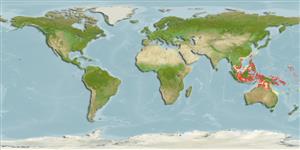>
Eupercaria/misc (Various families in series Eupercaria) >
Labridae (Wrasses) > Bodianinae
Etymology: Choerodon: Greek, choiros = a pig + odous = teeth (Ref. 45335); referrring to the prominent anterior canines of the species in this genus (Ref. 116605).
More on author: Bleeker.
Environment: milieu / climate zone / depth range / distribution range
Ecologia
marino demersale; distribuzione batimetrica 10 - 40 m (Ref. 90102), usually ? - 20 m (Ref. 48636). Tropical
Western Central Pacific: East Indies and the Philippines.
Size / Peso / Age
Maturity: Lm ? range ? - ? cm
Max length : 25.0 cm TL maschio/sesso non determinato; (Ref. 90102)
Spine dorsali (totale): 13; Raggi dorsali molli (totale): 7; Spine anali 3; Raggi anali molli: 10. A broad pale band directed from below base of last few dorsal-fin spines to upper side of pectoral-fin base; a large dark spot situated dorsally on side and on ventral edge of dorsal fin at dorsoposterior end of pale band, usually extending anteroventrally as a dark tapering marginal band on pale band at least along posteroventral edge; caudal fin uniformly pale in adults. (Ref 9823)
Found on semi-open sandy substrates along reefs, often in deep channels to lagoons that are prone to strong tidal currents and where seawhips thrive (Ref. 48636).
Life cycle and mating behavior
Maturità | Riproduzione | Deposizione | Uova | Fecundity | Larve
Oviparous, distinct pairing during breeding (Ref. 205).
Herre, A.W.C.T., 1953. Check list of Philippine fishes. Res. Rep. U.S. Fish Wild. Serv. (20):1-977. (Ref. 280)
IUCN Red List Status (Ref. 130435)
Threat to humans
Harmless
Human uses
Informazioni ulteriori
BibliografiaAcquacolturaProfilo di acquacolturaVarietàGeneticaElectrophoresesEreditarietàMalattieElaborazioneNutrientsMass conversion
CollaboratoriImmaginiStamps, Coins Misc.SuoniCiguateraVelocitàModalità di nuotoArea branchialeOtolithsCervelliVista
Strumenti
Special reports
Download XML
Fonti Internet
Estimates based on models
Preferred temperature (Ref.
123201): 26.9 - 29, mean 28.2 °C (based on 124 cells).
Phylogenetic diversity index (Ref.
82804): PD
50 = 0.5000 [Uniqueness, from 0.5 = low to 2.0 = high].
Bayesian length-weight: a=0.01318 (0.00582 - 0.02984), b=3.05 (2.86 - 3.24), in cm total length, based on LWR estimates for this (Sub)family-body shape (Ref.
93245).
Trophic level (Ref.
69278): 3.4 ±0.4 se; based on size and trophs of closest relatives
Resilienza (Ref.
120179): Medio, tempo minimo di raddoppiamento della popolazione 1.4 - 4.4 anni (Preliminary K or Fecundity.).
Fishing Vulnerability (Ref.
59153): Low vulnerability (15 of 100).
Nutrients (Ref.
124155): Calcium = 174 [90, 339] mg/100g; Iron = 1.15 [0.62, 2.29] mg/100g; Protein = 18.1 [15.3, 20.2] %; Omega3 = 0.264 [0.153, 0.463] g/100g; Selenium = 39.3 [20.4, 81.1] μg/100g; VitaminA = 37.5 [10.4, 146.9] μg/100g; Zinc = 1.24 [0.86, 2.04] mg/100g (wet weight);
